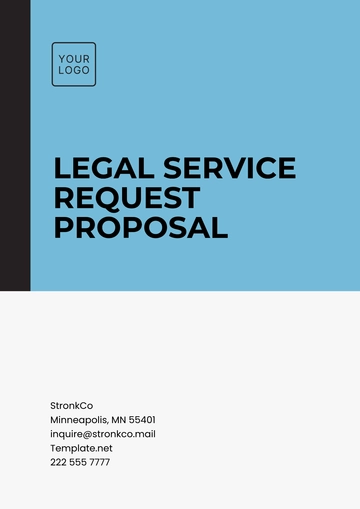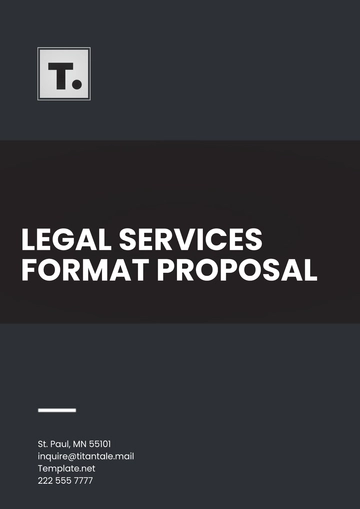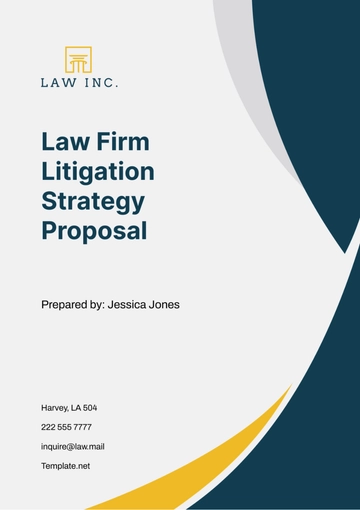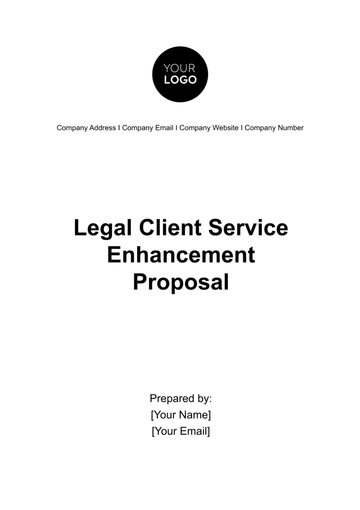Free Law Firm Project Proposal

I. Introduction
This proposal is designed to provide a comprehensive legal project management solution for [Your Company Name]. The aim is to streamline operations, minimize risks, and optimize the effectiveness of legal services provided to the firm’s clientele.
A. Purpose of the Proposal
The purpose of this proposal is threefold:
Operational Streamlining: The primary purpose of this proposal is to streamline the operations of [Your Company Name]. By implementing efficient processes and leveraging advanced technology, we aim to enhance the overall performance of the firm. This will not only improve the quality of service delivery but also increase the speed at which tasks are completed, leading to higher productivity and client satisfaction.
Risk Minimization: Another key purpose is to minimize the risks associated with legal tasks. This includes both operational risks and legal risks. By identifying potential risks early and implementing effective mitigation strategies, we can significantly reduce these risks. This proactive approach to risk management will ensure that the firm is always prepared to handle any challenges that may arise.
Service Optimization: The proposal also aims to optimize the legal services provided to clients. This includes improving the quality of services, enhancing client satisfaction, and improving client outcomes. By focusing on client needs and continuously improving our services, we aim to build strong relationships with our clients and ensure their satisfaction.
B. Scope of the Proposal
The scope of this proposal covers all aspects of [Your Company Name]'s operations:
Legal Processes: The proposal covers all legal processes at [Your Company Name]. This includes case management, client service, risk management, and other related processes. By improving these processes, we aim to enhance the efficiency and effectiveness of the firm’s operations.
Operational Costs: The proposal also covers the operational costs associated with legal tasks. By improving operational efficiency, we aim to reduce these costs. This will not only improve the firm’s financial performance but also allow it to invest more resources in improving its services.
Client Outcomes: The proposal aims to improve client outcomes. This includes both the results of legal cases and the overall satisfaction of clients. By focusing on client outcomes, we aim to enhance the firm's reputation and attract more clients.
C. Benefits of the Proposal
The implementation of this proposal is expected to bring about significant benefits to [Your Company Name]:
Operational Efficiency: By streamlining operations and implementing efficient processes, the proposal will enhance the operational efficiency of [Your Company Name]. This will not only improve the speed and quality of service delivery but also reduce the resources required for each task, leading to significant cost savings.
Cost Savings: The proposal will also lead to significant cost savings. By reducing operational costs and optimizing resource utilization, the firm can save a substantial amount of money. These savings can be reinvested in the firm to further improve its services and client satisfaction.
Client Satisfaction: The proposal will enhance client satisfaction. By improving the quality of services and client outcomes, the firm can enhance its reputation and attract more clients. Satisfied clients are more likely to refer others to the firm, leading to increased business.
II. Methodology
To achieve the objectives outlined in this proposal, our approach will include the assessment of current legal processes and infrastructure, implementation of project management tools tailored for legal environments, and regular reviews and optimizations based on performance metrics and feedback.
A. Assessment
The first step in our methodology is to assess the current state of [Your Company Name]'s legal processes and infrastructure. This involves several key activities:
Process Evaluation: We will conduct a thorough evaluation of the current legal processes at [Your Company Name]. This will involve reviewing all existing processes, identifying bottlenecks and inefficiencies, and understanding the impact of these processes on the firm’s operations and client outcomes.
Infrastructure Review: We will review the existing infrastructure at [Your Company Name], including both physical and digital infrastructure. This will involve assessing the adequacy of the current infrastructure in supporting efficient and effective legal processes.
Gap Analysis: We will conduct a gap analysis to identify the difference between the current state and the desired state of legal processes and infrastructure at [Your Company Name]. This will involve comparing the current state of affairs with best practices in the legal industry and identifying areas for improvement.
Stakeholder Interviews: We will conduct interviews with key stakeholders, including staff members, management, and clients, to gain insights into their experiences and perceptions of the current legal processes and infrastructure.
Benchmarking: We will benchmark [Your Company Name]'s current legal processes and infrastructure against those of leading firms in the legal industry. This will provide valuable insights into potential areas for improvement.
B. Implementation
The second step in our methodology is to implement project management tools tailored for legal environments and redesign the legal processes based on the findings of the assessment phase.
Project Management Tools: We will implement project management tools that are specifically tailored for legal environments. These tools will help in efficient task management, resource allocation, and risk management.
Process Redesign: We will redesign the legal processes based on the findings of the assessment phase. The redesigned processes should aim at improving efficiency and reducing costs.
Technology Integration: We will integrate advanced technology into [Your Company Name]'s operations. This includes legal research tools, document management systems, and other legal tech solutions that can automate routine tasks and improve the accuracy and speed of legal work.
Training: We will conduct training sessions to ensure that all team members are adept at using the new processes and tools.
Change Management: We will implement a change management plan to ensure a smooth transition to the new processes and tools. This will involve communicating the changes to all stakeholders, providing support during the transition phase, and addressing any issues or concerns that may arise.
C. Review and Optimization
The third step in our methodology is to conduct regular reviews and optimizations based on performance metrics and feedback.
Performance Monitoring: We will regularly monitor performance metrics to assess the effectiveness of the implemented changes. This will involve tracking key performance indicators (KPIs), such as process efficiency, cost savings, and client satisfaction.
Feedback Incorporation: We will incorporate feedback from team members and clients to make continuous improvements. This will involve conducting regular feedback sessions and making necessary changes based on the feedback received.
Continuous Improvement: We will adopt a continuous improvement approach, which involves regularly reviewing and updating the legal processes and tools based on performance feedback and changing legal industry trends.
Risk Monitoring: We will continuously monitor and manage risks associated with the new processes and tools. This will involve identifying potential risks, implementing mitigation strategies, and monitoring the effectiveness of these strategies.
Benchmarking: We will continue to benchmark [Your Company Name]'s legal processes and infrastructure against those of leading firms in the legal industry. This will provide valuable insights into potential areas for further improvement.
III. Project Timeline
At [Your Company Name], we understand the importance of a well-structured project timeline in ensuring the successful implementation of our legal project management solution. The following table presents a tentative timeline for the project:
Phase | Description | Duration |
|---|---|---|
Assessment | Evaluation of current processes and infrastructure | 1 month |
Implementation | Implementation of new processes and tools | 2 months |
Review and Optimization | Regular review and optimization of processes | Ongoing |
A. Assessment Phase
The assessment phase, scheduled to last for one month, involves a comprehensive evaluation of our current processes and infrastructure. This phase is crucial as it allows us to identify areas of improvement and set the foundation for the subsequent phases. During this phase, we will conduct a thorough review of our existing legal processes, identify bottlenecks, and understand the impact of these processes on our operations and client outcomes.
B. Implementation Phase
The implementation phase, expected to last for two months, involves the introduction of new processes and tools tailored for our legal environment. This phase is pivotal as it translates the insights gained during the assessment phase into actionable strategies. We will implement project management tools, redesign our legal processes, and integrate advanced technology into our operations. We will also conduct training sessions to ensure that all team members are adept at using the new processes and tools.
C. Review and Optimization Phase
The review and optimization phase is an ongoing process that begins after the implementation phase. This phase is vital as it allows us to continuously improve our processes and tools based on performance feedback and changing legal industry trends. We will regularly monitor performance metrics, incorporate feedback from team members and clients, and make necessary adjustments to our processes and tools.
The project timeline is a strategic tool that guides us through the project, helps us manage our resources effectively, and ensures that we stay on track to achieve our objectives. Each phase of the timeline has been carefully planned to ensure that we have adequate time to complete all necessary tasks without compromising on the quality of our work.
Moreover, the timeline serves as a roadmap for the implementation of our legal project management solution. It outlines the path we intend to take to streamline our operations, minimize risks, and optimize the effectiveness of our legal services. By adhering to this timeline, we are confident that we can achieve our objectives and enhance the value we provide to our clients.
IV. Budget
A budget plan allows us to manage our resources effectively, ensure that all activities are financially feasible, and provide transparency to all stakeholders. The following pie chart and table present a tentative budget for the project:
Item | Cost |
|---|---|
Project Management Software | $10,000 |
Professional Fees | $30,000 |
Training Materials | $5,000 |
Infrastructure Upgrade | $15,000 |
Contingency Fund | $10,000 |
Total | $70,000 |
A. Project Management Software
The budget allocates $10,000 for the purchase of project management software. This software is essential for task scheduling, risk management, and overall project coordination. It will provide a centralized platform for managing all project activities, thereby enhancing efficiency and ensuring that all tasks are completed on time and within budget.
B. Professional Fees
The budget includes $30,000 for professional fees. This covers the cost of consultation with top legal project management experts. Their expertise and guidance will be invaluable in ensuring the successful implementation of the project. They will provide advice on best practices, help us avoid common pitfalls, and ensure that our approach aligns with industry standards.
C. Training Materials
$5,000 has been allocated for training materials. These materials are necessary to ensure that all team members are adept at using the new tools and processes. The training will cover the use of the project management software, the new legal processes, and other relevant topics. It will ensure that all team members have the skills and knowledge needed to effectively contribute to the project.
D. Infrastructure Upgrade
The budget includes $15,000 for necessary upgrades to the firm’s infrastructure. These upgrades are necessary to support the new processes and tools. They may include hardware upgrades, software installations, and other modifications to the firm’s IT infrastructure.
E. Contingency Fund
Finally, the budget includes a $10,000 contingency fund. This fund is reserved for unexpected costs or overruns. It provides a financial cushion that can help us navigate any unforeseen challenges that may arise during the project.
The budget is more than just a financial plan. Each item in the budget has been carefully planned to ensure that we have adequate resources to complete all necessary tasks without compromising on the quality of our work.
Moreover, the budget reflects our commitment to transparency and accountability. By providing a detailed breakdown of costs, we ensure that all stakeholders have a clear understanding of how resources are being allocated. This transparency builds trust and fosters a sense of ownership among all team members.
V. Projected Benefits
At [Your Company Name], we believe that the implementation of our comprehensive legal project management solution will bring about significant benefits. These benefits will not only improve our internal operations but also enhance the value we provide to our clients.
A. Operational Efficiency
Streamlined Processes: By streamlining our legal processes, we can significantly enhance the speed and quality of service delivery. This will allow us to handle more cases effectively and provide timely services to our clients.
Automated Routine Tasks: Automation of routine tasks will free up our legal team’s time, allowing them to focus on more complex and critical aspects of our legal services. This will also reduce the chances of human error in these tasks.
Improved Decision Making: With the help of the project management solution, we can have better visibility and control over our legal projects. This will lead to improved decision making, as we will have all the necessary information at our fingertips.
Increased Productivity: With streamlined processes and automated tasks, our team can work more efficiently. This will increase our overall productivity, allowing us to serve more clients without compromising on the quality of our services.
Enhanced Client Services: With improved operational efficiency, we can respond to our clients’ needs more quickly and effectively. This will enhance our client services and lead to higher client satisfaction.
B. Cost Savings
Reduced Operational Costs: By improving our operational efficiency, we can significantly reduce our operational costs. This includes savings on manpower, infrastructure, and other resources.
Optimized Resource Utilization: With the help of the project management solution, we can optimize our resource utilization. This means we can get the most out of our available resources, leading to further cost savings.
Prevention of Costly Errors: The project management solution will help us prevent costly errors in our legal projects. This includes errors in legal documentation, compliance issues, and missed deadlines.
Long-Term Savings: While the implementation of the project management solution requires an initial investment, it will lead to significant long-term savings. The cost savings from improved efficiency and error prevention will quickly offset the initial investment.
C. Client Satisfaction
Timely Services: With improved operational efficiency, we can provide our services to our clients more quickly. This will lead to higher client satisfaction, as clients appreciate timely services.
High-Quality Services: The project management solution will help us maintain high standards of quality in our legal services. This includes accurate legal documentation, effective legal advice, and successful legal representation.
Transparent Communication: The project management solution will enable transparent communication with our clients. Clients will have a clear understanding of the progress of their legal projects, which will enhance their trust in our services.
Personalized Services: With the help of the project management solution, we can provide personalized services to our clients. We can tailor our services to meet the specific needs and preferences of each client, leading to higher client satisfaction.
Improved Client Outcomes: With high-quality, timely, and personalized services, we can improve the outcomes for our clients. This includes winning legal cases, achieving favorable legal agreements, and meeting other legal objectives.
VI. Risks and Mitigation
At [Your Company Name], we understand that implementing a comprehensive legal project management solution comes with its own set of risks. However, we believe that with careful planning and proactive risk management, these risks can be effectively mitigated.
A. Resistance to Change
Understanding the Resistance: Resistance to change is a common phenomenon in any organization. It’s important to understand that this resistance often stems from fear of the unknown. Therefore, the first step in mitigating this risk is to understand the root causes of the resistance.
Communication: Clear and transparent communication about the changes, the reasons behind them, and the benefits they will bring is crucial in overcoming resistance. This includes regular updates, presentations, and Q&A sessions.
Involvement: Involving team members in the change process can also help mitigate resistance. This could be in the form of brainstorming sessions, pilot projects, or feedback sessions.
Training: Providing adequate training to the team members will ensure that they have the necessary skills to adapt to the new processes and tools. This will not only make the transition smoother but also help in building confidence among the team members.
Support: Providing continuous support during and after the transition phase is crucial. This could be in the form of a helpdesk, mentorship programs, or regular check-ins.
B. Technical Challenges
Expert Consultation: Technical challenges are inevitable when implementing new software tools. Consulting with experts can help us anticipate these challenges and prepare for them in advance.
Pilot Testing: Conducting pilot testing before full-scale implementation can help us identify potential technical issues and address them before they affect the entire organization.
Training: Providing thorough training to the team members can ensure that they are comfortable with the new software tools and can use them effectively.
Technical Support: Having a dedicated technical support team can ensure that any technical issues that arise are promptly addressed.
Regular Updates and Maintenance: Regular updates and maintenance of the software tools can prevent potential technical issues and ensure smooth operation.
C. Project Management Risks
Project Planning: Detailed and realistic project planning can help mitigate risks related to project management. This includes setting clear objectives, defining scope, and developing a realistic timeline.
Resource Management: Effective resource management can ensure that the project has all the necessary resources it needs at the right time. This includes human resources, financial resources, and technical resources.
Risk Management Plan: Developing a comprehensive risk management plan can help us anticipate potential project risks and develop strategies to mitigate them.
Monitoring and Control: Regular monitoring and control of the project can ensure that it stays on track and any deviations are promptly addressed.
Communication: Effective communication among the project team and with stakeholders can ensure that everyone is on the same page and any issues are promptly addressed.
D. Financial Risks
Financial Planning: Effective financial planning can help us anticipate potential financial risks and develop strategies to mitigate them. This includes developing a realistic budget, managing our resources effectively, and planning for contingencies.
Financial Monitoring: Regular monitoring of our financial performance can help us identify any deviations from our financial plan and take corrective action in a timely manner.
Financial Controls: Implementing effective financial controls can help us manage our financial resources effectively and avoid potential financial risks. This includes controls over our spending, investments, and revenue collection.
Financial Reporting: Regular financial reporting can provide us with valuable insights into our financial performance and help us make informed financial decisions.
Financial Advice: Consulting with financial experts can provide us with valuable advice on how to manage our financial resources effectively and avoid potential financial risks.
VII. Conclusion
The implementation of a comprehensive legal project management solution at [Your Company Name] promises to bring about significant improvements in our operations, client services, and overall business performance. By streamlining our processes, minimizing risks, and optimizing our services, we aim to enhance our value proposition and solidify our position in the legal services market. The strategies outlined in this proposal have been carefully designed to align with our firm’s goals and values, ensuring that we continue to uphold our commitment to excellence and client satisfaction.
The success of this proposal, however, hinges on the collective efforts of our entire team. From the initial assessment phase to the ongoing review and optimization phase, every team member has a crucial role to play. Through effective communication, collaboration, and commitment to continuous learning and improvement, we can successfully navigate the challenges of this project and realize its full potential. We believe that with everyone’s cooperation and dedication, we can turn this proposal into a reality and achieve the objectives we have set out.
Looking ahead, we are excited about the opportunities that this project presents. Not only does it promise to improve our current performance, but it also prepares us for future growth and success. As we navigate the ever-evolving legal landscape, we are confident that this project will equip us with the tools and strategies we need to adapt, innovate, and thrive. We look forward to embarking on this journey and witnessing the transformative impact of this project on [Your Company Name].
- 100% Customizable, free editor
- Access 1 Million+ Templates, photo’s & graphics
- Download or share as a template
- Click and replace photos, graphics, text, backgrounds
- Resize, crop, AI write & more
- Access advanced editor
Secure new clients and projects with ease our Law Firm Project Proposal Template! This editable proposal from Template.net offers a professional format for presenting your firm's expertise and unique approach to potential clients. Utilize our advanced AI Editor Tool and customizable features to customize the proposal to your specific needs!
You may also like
- Business Proposal
- Research Proposal
- Proposal Request
- Project Proposal
- Grant Proposal
- Photography Proposal
- Job Proposal
- Budget Proposal
- Marketing Proposal
- Branding Proposal
- Advertising Proposal
- Sales Proposal
- Startup Proposal
- Event Proposal
- Creative Proposal
- Restaurant Proposal
- Blank Proposal
- One Page Proposal
- Proposal Report
- IT Proposal
- Non Profit Proposal
- Training Proposal
- Construction Proposal
- School Proposal
- Cleaning Proposal
- Contract Proposal
- HR Proposal
- Travel Agency Proposal
- Small Business Proposal
- Investment Proposal
- Bid Proposal
- Retail Business Proposal
- Sponsorship Proposal
- Academic Proposal
- Partnership Proposal
- Work Proposal
- Agency Proposal
- University Proposal
- Accounting Proposal
- Real Estate Proposal
- Hotel Proposal
- Product Proposal
- Advertising Agency Proposal
- Development Proposal
- Loan Proposal
- Website Proposal
- Nursing Home Proposal
- Financial Proposal
- Salon Proposal
- Freelancer Proposal
- Funding Proposal
- Work from Home Proposal
- Company Proposal
- Consulting Proposal
- Educational Proposal
- Construction Bid Proposal
- Interior Design Proposal
- New Product Proposal
- Sports Proposal
- Corporate Proposal
- Food Proposal
- Property Proposal
- Maintenance Proposal
- Purchase Proposal
- Rental Proposal
- Recruitment Proposal
- Social Media Proposal
- Travel Proposal
- Trip Proposal
- Software Proposal
- Conference Proposal
- Graphic Design Proposal
- Law Firm Proposal
- Medical Proposal
- Music Proposal
- Pricing Proposal
- SEO Proposal
- Strategy Proposal
- Technical Proposal
- Coaching Proposal
- Ecommerce Proposal
- Fundraising Proposal
- Landscaping Proposal
- Charity Proposal
- Contractor Proposal
- Exhibition Proposal
- Art Proposal
- Mobile Proposal
- Equipment Proposal
- Student Proposal
- Engineering Proposal
- Business Proposal
















